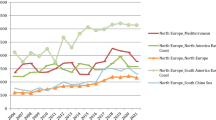Abstract
Liner shipping firms have long argued that the task of providing adequate service to shippers while earning reasonable rates of return on capital requires at least some form of limited antitrust immunity. Carriers contend that because scheduling requirements unique to liner shipping firms constrains their ability to adjust capacity to meet market conditions, liner shipping capacity is essentially fixed in the short term while demand is variable. And because individual firms have incentive to minimise unit costs by maximising capacity utilisation on every voyage, the threat of destructive price wars looms large. Consequently, carriers have advocated that governments leave them free to form collusive arrangements called conferences in which members are free to meet to discuss and fix prices. But how rigid is liner shipping capacity? Because of a lack of useable data on prices and capacity, this question has never been resolved empirically. But recently, new data have become available from public and industry sources that permit researchers to look more deeply into this issue. In this paper, those data are used to estimate a partial adjustment, distributed lag supply function for liner shipping services in US trade lanes. The results reveal that, on the major US import trade lanes, liner shipping supply curve exhibits more flexibility than the ‘stylised facts’ of the industry would suggest.
Access this article
We’re sorry, something doesn't seem to be working properly.
Please try refreshing the page. If that doesn't work, please contact support so we can address the problem.





Similar content being viewed by others
Notes
See Sjostrom (1989) and Pirrong (1992) for a discussion of core emptiness in liner shipping.
Sletmo and Williams (1981) classic text is aging but is still relevant in explaining the idiosyncrasies of liner shipping.
According to data from PIERS and the United States Federal Maritime Commission (1996), 2000).
Containerization International December, 2003.
Caballero and Engel (2003) have recently shown that when adjustments are lumpy, the partial adjustment model will overestimate the speed of adjustment parameter.
Based on conversation with staff at the World Shipping Council, Washington, DC.
References
Caballero, R and Engel, EM . (2003): Adjustment is much slower than you think. Yale University Discussion paper no. 865, Cowles Foundation.
Evans, M . (1967): A study of investment decisions. The Review of Economics and Statistics 49: 151–164.
Federal Maritime Commission. (1996): Global strategic alliances: Where we are today. Staff report, Bureau of Economics and Agreement Analysis, Washington, DC.
Federal Maritime Commission. (2000): The ocean shipping reform act: An interim status report. Staff report. Bureau of Economics and Agreement Analysis, Washington, DC.
Feldstein, M, Auerbach, A, Hall, R and Lovell, MC . (1976): Inventory behaviour in durable-goods manufacturing: The target-adjustment model. Brookings Papers On Economic Activity 2: 351–408.
Fisher, FM, Cootner, PH and Baily, MN . (1972): An econometric model of the world copper industry. The Bell Journal of Economics and Management Science 3: 509–568.
Griliches, Z . (1967): Distributed lags: A survey. Econometrica 35: 16–49.
Haralambides, HE . (2004): Determinants of price and price stability in liner shipping. Workshop on The Industrial Organization of Shipping and Ports, National University of Singapore, 5–6 March 2004, Singapore.
Haralambides, HE and Veenstra, AW . (2000): Modelling performance in liner shipping. In: Button, KJ and Hensher, DA (eds). Handbook of Transport Modelling. Pergamon-Elsevier Science: New York.
Husted, SL and Kollintzas, TE . (1984): Distributed lags and intermediate goods imports. Journal of Economic Dynamics and Control December: 302–328.
Jorgenson, DW and Handel, SS . (1971): Investment Behaviour in U.S. Regulated Industries. The Bell Journal of Economics and Management Science 2: 213–263.
King, RG and Thomas, JK . (2003): Partial adjustment without apology. Research Department Staff Report 327, Federal Reserve Bank of Minneapolis, November, 2003.
Koyck, LM . (1954): Distributed lags and investment analysis. North-Holland: Amsterdam.
McCallum, BT . (1970): The effect of demand on prices in British manufacturing: Another view. The Review of Economic Studies 37: 147–156.
Pagan, AR and Volker, PA . (1981): The short-run demand for transactions balances in Australia. Economica 48: 381–395 (New Series).
Pirrong, S . (1992): An application of core theory to the analysis of ocean shipping markets. Journal of Law and Economics XXXV: 89–131.
Sjostrom, W . (1989): Collusion in ocean shipping: A test of monopoly and empty core models. Journal of Political Economy 97: 1160–1179.
Sletmo, GK and Williams, EW . (1981): Liner conferences in the container age, U.S. policy at sea. Studies of the Modern Corporation, Graduate School of Business, Columbia University.
Waud, RN . (1968): Misspecification in the ‘partial adjustment’ and ‘adaptive expectations’ models. International Economic Review 9: 204–217.
Author information
Authors and Affiliations
Rights and permissions
About this article
Cite this article
Fusillo, M. Is Liner Shipping Supply Fixed?. Marit Econ Logist 6, 220–235 (2004). https://doi.org/10.1057/palgrave.mel.9100110
Published:
Issue Date:
DOI: https://doi.org/10.1057/palgrave.mel.9100110




